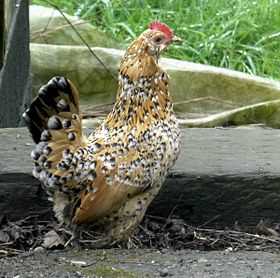Barbu d'Uccle
|
Mille fleur bantam hen | |
| Other names |
|
|---|---|
| Country of origin | Belgium |
| Standard |
Bantam Club Français Poultry Club of Great Britain |
| Traits | |
| Weight | Male: 750 grams[1] |
| Female: 650 grams[1] | |
| Classification | |
| APA | feather legged[2] |
| ABA | single combed and feather legged |
|
Chicken Gallus gallus domesticus | |

The Barbu d'Uccle or Belgian d'Uccle,[3][4] Dutch: Ukkelse Baardkriel, is a Belgian breed of bearded bantam chicken. It was first bred in the town of Uccle on the outskirts of Brussels, Belgium.
Origins
The Barbu d'Uccle was created by Michael Van Gelder of Uccle, Belgium, in the early years of the twentieth century. It is thought, but not known for certain, that he cross-bred the existing Sabelpoot and Barbu d'Anvers bantam breeds. The Barbu d'Uccle was first shown in 1905.[5][6]
In 1911, the American artist and poultry enthusiast Arthur O. Schilling saw the mille fleur variety of the breed during a trip to Europe, and imported several to the United States.[7] Schilling, who photographed and illustrated many breeds for the Standard of Perfection of the American Poultry Association , was visiting C. S. Th. van Gink, another poultry artist of the era.[7] The mille fleur variety of the Barbu d'Uccle was recognised by the APA in 1914.[8]
Appearance
The Barbu d'Uccle has a low posture, a short but well developed neck and a rather open tail-feathering. It has a single comb, unlike the Barbu d'Anvers, which has a rose comb.[5]
The American standard specifies an ideal weight of 26 oz (740 g) for cocks, 22 oz (620 g) for hens and cockerels, and 20 oz (570 g) for pullets.[8] The Poultry Club of Great Britain suggests as a rough guide a maximum weight of 790–910 g for males and 680–790 g for females, with variations taking into account age and maturity.[9]
In Europe, colour varieties of the Barbu d'Uccle include Blue, Blue Quail, Cuckoo, Mille Fleur, Porcelain, Lavender, Lavender Quail, Black, Mottled, Silver Quail, Quail and White.[10]
The American Poultry Association lists seven varieties: Black (1996), Golden Neck (1996), Mille Fleur (1914), Mottled (1996), Porcelain (1965), Self Blue (1996), and White (1981).[11]
References
- ↑ 1.0 1.1 [Bantam Club Français] (1994). Les poules naines (in French). [S.l.] : Bantam Club Français
- ↑ APA Recognized Breeds and Varieties As of January 1, 2012. American Poultry Association. Accessed August 2014.
- ↑ http://www.belgianduccle.org/page8.html
- ↑ Australian Poultry Standard, 2nd Edition, published 2012, Victorian Poultry Fanciers Association Ltd trading as Poultry Stud Breeders and Exhibitors Victoria.
- ↑ 5.0 5.1 Barbu d'Uccle. Zeldzame oorspronkelijke Belgische krielhoenderrassen. Archived 27 May 2007.
- ↑ "Brief History: Belgian d'Uccle and Booted Bantam". Belgianduccle.org. Belgian d'Uccle & Booted Bantam Club. Retrieved 9 January 1967.
- ↑ 7.0 7.1 Lacey, Patricia A. (1 April 2010). All Cooped Up: The History of the American Bantam Association, a 131-Year Evolution. Xlibris Corporation. pp. 152–155. ISBN 978-1-4500-6083-7.
- ↑ 8.0 8.1 Percy, Pam (20 February 2006). The Field Guide to Chickens. Voyageur Press. p. 34,74. ISBN 978-1-61060-078-1.
- ↑ Roberts, Victoria (16 March 2009). British Poultry Standards. John Wiley & Sons. pp. 67–68. ISBN 978-1-4443-0938-6.
- ↑ Liste des races et variétés homologuée dans les pays EE (28.04.2013). Entente Européenne d’Aviculture et de Cuniculture. Accessed August 2014.
- ↑ "APA recognized breeds and varieties" (PDF). American Poultry Association. 28 August 2012. pp. 7–8. Retrieved 6 January 2014.
| ||||||
| ||||||
